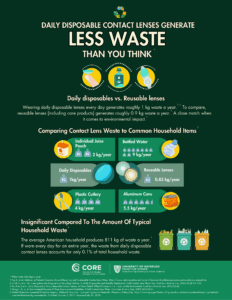
How much waste is generated from wearing daily disposable contact lenses?
Daily disposable contact lenses offer patients a convenient and healthy approach to lens wear. A fresh lens every day, no cleaning concerns, and having spare lenses to hand are a few of the reasons why patients enjoy the freedom of daily disposable lenses.
As we start to fit younger patients as part of myopia control care, you may find parents, children, and young adults presenting with concerns about the amount of waste that comes from wearing their contact lenses every day. This short summary provides a number of facts to enable you to have an informed conversation on this topic with your patients.
The wider context
First, let’s put things into perspective: how much household waste does the average person make every year anyway? Data from 2017 to 2020 reveals that the average person disposes between 286kg to 811kg of waste a year and this varies tremendously by country.1-3



Comparisons to other daily life actions
Second, how much waste is generated from things we might do every day, such as drinking, eating, and snacking? One study found that drinking one 591ml bottle of water every day produces 9 kg of waste per year, whereas wearing a new pair of daily disposable contact lenses every day produces only 1 kg of waste over year.4,5 Similarly, using a set of plastic cutlery every day, and daily consumption of a beverage in an aluminium can or a juice pouch all far exceed the amount of waste per year compared to daily wear of daily disposable or reusable contact lenses (care products were factored into this calculation). Even drinking a takeaway coffee in a single-use cup every day for one whole year generates 60kg of plastic.6
Figure 1: The amount of waste arising from daily consumption of single-use beverages and utensils is far greater than the amount of waste arising from daily wear of contact lenses. Data from Routhier et al, 2012.5

Putting it together
References & Resources
1. United States Environmental Protection Agency. National Overview: Facts and Figures on Materials, Wastes and Recycling. Published October 2, 2017. Accessed April 16, 2025.
2. Department for Environment, Food & Rural Affairs (Defra). Digest of Waste and Resource Statistics – 2018 Edition. Published May 2018. Accessed April 16, 2025.
3. Environment and Climate Change Canada. Solid waste diversion and disposal. Published 2023. Accessed April 16, 2025.
4. Smith SL, Orsborn GN, Sulley A, et al. An investigation into disposal and recycling options for daily disposable and monthly replacement soft contact lens modalities. Cont Lens Anterior Eye 2022;45(2):101435.
5. Routhier J, Freitas MD, Hickson-Curran S. Daily disposable versus reusable contact lenses: a close match when it comes to the impact on the environment. Cont Lens Anterior Eye 2012;35:e2.
6. KeepCup. Impact Calculator. Accessed April 16, 2025.





